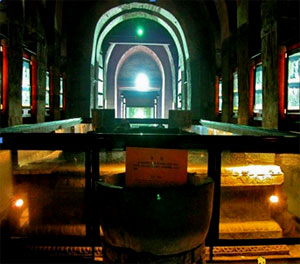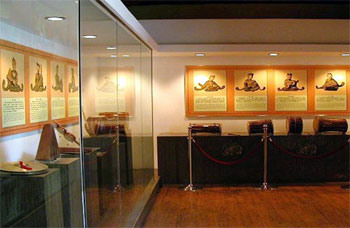Inside the Wang Jian tomb, you will notice a series of relief sculpture around the platform. It’s the most valuable relic in the tomb, I think. It consists of two dancers and another 22 musicians, who make up a court band. The feature attraction here is the relief of 24 musicians for their classical instruments. The dancers dance rhythmically with light steps, the musicians play their music instruments together. The music establishment looks very similar to the authentic portrait of a Tang court music band with northern Hebei style.
The fine relief carvings depict Tang musicians or musicians of the Former Shu state in this tomb. It was popular in the court of the Tang Dynasty as well as the Former Shu State. These reliefs of musicians have provided valuable research evidence of the imperial music of the Tang Dynasty. Some musicians have faded through ages, and some are still vivid. The archeologists also find out the carved Tang styled clothing. This carved band has its own distinctive features as following:
- A. There are 23 musical instruments. 20 of them are in different shapes.
- B. Each musician is beautifully shaped and are dynamically dancing or playing their instruments. They all have a full moon shaped face and delicate features.
The carved figures help us gain some insight in the aspects of the use of ancient musical instrument and social status. On either side of the coffin platform stand 12 carved stone busts. They are called 12 men of great strength in suits of armor. Their hands stretch under the platform as if they were ready to lift up the platform and move it away. They have a ferocious profile looking towards the entrance gate. It is said that they work as tomb guards to drive out evil spirits.

Chinese Pipa Instrument
The Chines Pipa is a plucked instrument. It’s in a pear-shape with four strings and fretted fingerboard. The Pipa was introduced from west Asia and became one of the main music instruments during the Tang Dynasty and the Five Dynasties. The musician played music on the Pipa strings by moving them to and fro with a wooden stick. The Pipa and clapper musicians look a little taller and slightly different in their dress and hairstyles, compared with the other musicians. This difference indicates that the Pipa is the leading instrument, and the calpper is to keep the music beat.
Chinese Waist Drums - Zheng Drum and He Drum
The Zheng and the He drums are a pair of waist drums. A musician beats the Zheng drum with sticks held in both bands. The carved relief band has nine drums. Eight of them are different in shape. Besides the drums, there are clappers, bronze cymbals and a conch. The band consists of percussion and wind instruments. It is easy to imagine that when the band played the music would have surely sounded rapid and exciting.

Various ancient musical instruments on display.
Traditionally, the Chinese music band consists of stringed and wind instruments. The carved band has percussion instruments. This evidence shows that foreign music influenced traditional Chinese bands during the Tang Dynasty. Other Chinese music instruments include:
Bili - The Bili is a vertical bamboo flute. It is 40 cm long. A thin piece of wood or metal is inserted inside the top of the flute. A big flute has nine holes, a small one has six holes.
Jie Drum - The Jie drum is a two-stick drum. It’s one of the main percussion instruments in the Tang Dynasty. The drum is usually placed on a small ivory-inlaid bed.
Tao Drum and Jilou Drum - These two drums are played by one musician at the same time. The Tao drum is a rattle-drum. It makes quick and little sounds as the sticks hit the drum. The Jilou drum is usually pressed inside the armpit on the left, the right hand beats the drum with a stick.
Dala Drum - The Dala drum is in a flattened shape. It is beat by hands and looks similar to a tambourine, used by the Uygur and other nationalities.
Chuiye - The Chuiye means blowing a tree leaf. A musician extends her right forefinger and middle fingers first. She blows the tree leave with her fingertips pressing the leaf between her lips. The Chuiye is a kind of folk musical instrument. It is interesting to see that the simple instrument has joined in the court band. This evidence shows that ancient folk music also influenced the court music.
Shu Konghou (Harp) - The Shu konghou is a vertical instrument with 22-23 strings. Non-Han nationalities in the North and West often used this instrument during the Tang Dynasty. It looks like the current harp.
Xiao - The Xiao is a vertical bamoo flute. The carved flute has eight pipes in a row. Usually this kind of the instrument consists of 17 or 21 pipes. The musician squeezes a rolled paper into each pipe or seals it with wax to assure that it has the right music notes.
Continue to Part 3
|